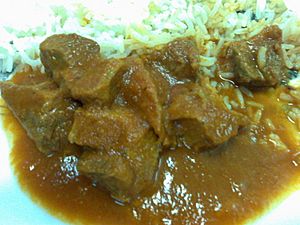Balichão facts for kids
Balichão is a special ingredient used in many dishes from Macanese cuisine. Macanese cuisine is the traditional food of Macau, a city in China with a rich history. Balichão is made from tiny shrimp (or sometimes krill), salt, pepper, bay leaves, and chili peppers. It also includes a bit of a strong alcoholic drink called aguardente.
Contents
What is Balichão?
Balichão is often described as a type of shrimp paste. However, some people say it is actually made from krill. Krill are very small sea creatures that look like tiny shrimp. Others describe Balichão as a kind of fish sauce.
Balichão is known for its very distinct smell. Some people find the smell quite strong or unusual. But others think its smell and taste are actually milder than other shrimp pastes from places like Southeast Asia.
The Story of Balichão
There are a couple of ideas about where the word balichão came from. One idea is that the name came from the Portuguese word for Whale (baleia). Another idea is that the word balichão is a changed version of belachang. Belachang is a Malay word for shrimp paste.
Balichão is thought to have started from shrimp pastes that Portuguese sailors brought to Macao. They discovered these pastes on their long sea journeys. Later, the people in Macao created their own special version of it.
Traditionally, Balichão was often made at home. It could take up to a month for the paste to be ready and taste just right. By 2009, Balichão was becoming less common. People started using other ingredients instead, as they were easier to find.
Ingredients in Balichão
Besides krill, Balichão contains several other ingredients. These include bay leaves, chili, clove, lime, and peppercorns. It also has a small amount of strong wine mixed in.
Balichão in Macanese Culture
Balichão is very important to the culture of Macao. It is so central that Macanese people sometimes call themselves balichung. This is a friendly nickname that shows their connection to this special food. There is even a street in Macao named after it. The street is called Travessa do Balichão, which means "Balichão Lane".


